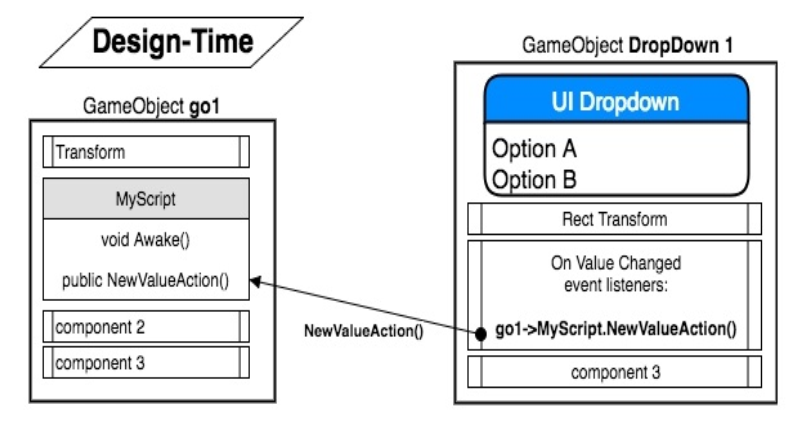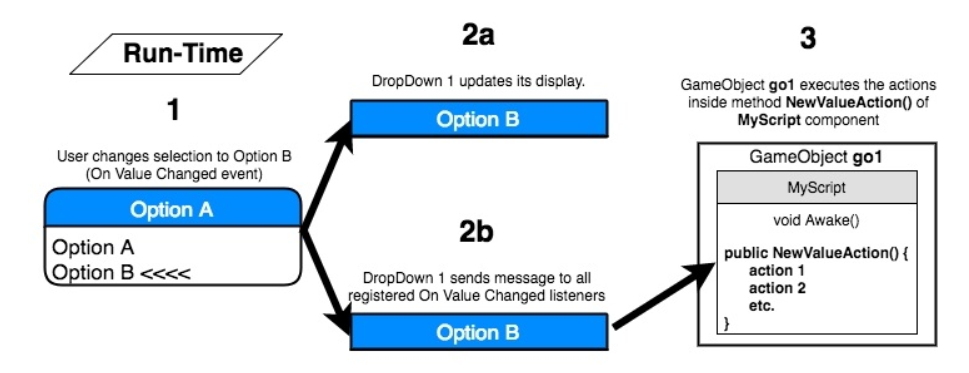Unity 2018 Cookbook (Matt Smith 著)
1. Displaying Data with Core UI Elements (已看)
2. Responding to User Events for Interactive UIs (已看)
3. Inventory UIs (已看)
4. Playing and Manipulating Sounds
5. Creating Textures, Maps, and Materials
6. Shader Graphs and Video Players
11. Webserver Communication and Online Version-Control
12. Controlling and Choosing Positions
13. Navigation Meshes and Agents
15. Editor Extensions and Immediate Mode GUI(IMGUI)
16. Working with External Resource Files and Devices
17. Working with Plain Text, XML, and JSON Text Files
18. Virtual Reality and Extra Features
1. Displaying Data with Core UI Elements
Introduction
Core GameObjects, components, and concepts relating to Unity UI development include:
- Canvas
- EventSystem
- Visual UI controls
- The Rect Transform component
Displaying a "Hellow World" UI text message
https://docs.unity3d.com/Manual/StyledText.html
Displaying a digital clock
Displaying a digital countdown timer
https://docs.unity3d.com/ScriptReference/RequireComponent.html
Create a message that fades away
Displaying a perspective 3D Text Mesh
https://docs.unity3d.com/Manual/class-TextMesh.html
Creating sophisticated text with TextMeshPro
http://digitalnativestudios.com/textmeshpro/docs/rich-text/
Displaying an image
Creating UIs with the Fungs open source dialog system
Creating a Fungus character dialog with images
https://github.com/snozbot/fungus
http://fungusdocs.snozbot.com/conversation_system.html
2. Responding to User Events for Interactive UIs
Introduction


Creating UI Buttons to move between scenes
Animating button properties on mouse-over
https://www.raywenderlich.com/6569-introduction-to-unity-ui-part-2
Organizing image panels and channing panel depths via buttons
Displaying the value of an interactive UI Slider
Displaying a countdown timer graphically with a UI Slider
Setting custom mouse cursors for 2D and 3D GameObjects
Setting custom mouse cursors for UI controls
Interactive text entry with an Input Field
https://docs.unity3d.com/Manual/script-InputField.html
Toggles and radio buttons via Toggle Groups
Creating text and image icon UI Dropdown menus
https://docs.unity3d.com/Manual/script-Dropdown.html
Displaying a radar to indicate the relative locations of objects
https://docs.unity3d.com/ScriptReference/Physics.Raycast.html
3. Inventory UIs
Introduction
Creating a simple 2D mini-game-SpaceGril
Displaying single object pickups with carrying and not-carrying text
Displaying single object pickups with carrying and not-carrying icons
Displaying multiple pickups of the same object with multiple status icons
Using panels to visually outline the inventory UI area and individual items
Creating a C# inventory slot UI display scripted component
Using UI Grid Layout Groups to automatically populate a panel
Displaying multiple pickups of different objects as a list of text via a dynamic List<> of scripted PickUp objects
Displaying multiple pickups of different objects as text totals via a dynamic Dictionary<> of PickUp objects and enum pickup types
https://learn.unity.com/tutorial/lists-and-dictionaries
4. Playing and Manipulating Sounds
Introduction
Playing different one-off sound effects with a single AudioSource component
Playing and controlling different sounds each with their own AudioSouce component
Creating just-in-time AudioSource components at runtime through C# scripting
Delaying before playing a sound
Preventing an Audio Clip from restarting if it is already playing
Waiting for the audio to finish playing before auto-destructing an object
Creating a metronome through the precise scheduling of sounds with dspTime
Matching the audio pitch to the animation speed
Simulating acoustic environments with Reverb Zones
Adding volume control with Audio Mixers
Making a dynamic soundtrack with Snapshots
Balancing in-game audio with Ducking
Audio visualization from sample specdtral data
Synchronizing simultaneous and sequential music to create a simple 140 bpm music-loop manager
5. Creating Textures, Maps, and Materials
Introduction
Creating a basic material with Standard Shader (Specular setup)
Adapting a basic material from Specular setup to Metallic
Applying Normal maps to a Material
Adding Transparency and Emission maps to a material
Highlighting materials at mouse-over
Adding Detail maps to a material
Fading the transparency of a material
6. Shader Graphs and Video Players
Introduction
Playing videos by manually adding a VideoPlayer component to a GameObject
Using scripting to control video playback on scene textures
Using scripting to play a sequence of videos back-to-back
Creating and using a simple Shader Graph
Creating a glow effect with Shader Graph
Toggling a Shader Graph color glow effect through C# code
7. Using Cameras
Introduction
Creating the basic scene for this chapter
Creating a picture-in-picture effect
Swithcing between multiple cameras
Making textures from screen content
Zooming a telescopic camera
Displaying a minimap
Creating an in-game surveillance Camera
Working with Unity's multi-purpose camera rig
Using Cinemachine ClearShot to switch cameras to keep the player in shot
Letting the player switch to a Cinemachine FreeLook camera
8. Lights and Effects
Introduction
Directional Light with cookie Texture to simulate a cloudy day
Creating and applying a cookie texture to as spotlight
Adding a custom Reflection map to a scene
Creating a laser aim with a projector
Enhancing the laser aim with a Line Renderer
Setting up an environment with Procedural Skybox and Directional Light
Reflecdting surrounding objects with Reflection Probes
Using Material Emission to bake light from a glowing lamp onto scene objects
Lighting a simple scene with Lightmaps and Light Probes
9. 2D Animation
Introduction
Flipping a sprite horizontally - the DIY approachj
Flipping a sprite horizontally - using Animator State Chart and Transitions
Animating body parts for character movement events
Creating a three-frame animation clip to make a platform continually animate
Making a platform start falling once stepped on using a Trigger to move animation from one state to another
Creating animation clips from sprite sheet sequences
Creating a platform game with Tiles and Tilemaps
Creating a game with the 2D Gamekit
10. 3D Animation
Introduction
Configuring a character's Avatar and idle animation
Moving your character with root motion and Blend Trees
Mixing animations with Layers and Masks
Organizing States into Sub-state Machiners
Transforming the Character Controller vias scripts
Adding rigid props to animated characters
Using Animation Events to throw an object
Applying Ragdoll physics to a character
Rotating the character's torso to aim a weapon
Creating geometry with Probuilder
Creating a game with the 3D Gamekit
Importing third-party 3D models and animations from Mixamo
11. Webserver Communication and Online Version-Control
Introduction
Setting up a leaderboard using PHP and a database
Unity game communication with web-server leaderboard
Creating and cloning a GitHub respository
Adding a Unity project to a local Git respository, and pushing files up to GitHub
Unity project version-control using GitHub for Unity
Preventing your game from running on unknown servers
12. Controlling and Choosing Positions
Introduction
Player control of a 2D GameObject (and limiting the movement within a rectangle)
Player control of a 3D GameObject (and limiting the movement within a rectangle)
Choosing destinations - finding a random spwan point
Choosing destinations - finding the nearest spawn point
Choosing destinations - respawning to the most recently passed checkpoint
Moving objects by clicking on them
Firing projectiles in the direction of movement
13. Navigation Meshes and Agents
Introduction
NPC to travel to destination while avoiding obstacles
NPC to seek or flee from a moving object
Point-add-click move to object
Point-and-click move to die
Point-and-click Raycast with use-defined higher-cost Navigation Areas
NPC NavMeshAgent to follow waypoints in a sequence
Controlling object group movement through flocking
Creating a movable NavMesh Obstacle
14. Design Patterns
Introduction
State-driven behavior DIY states
State-driven behavior using the State Design Pattern
State-driven behavior with Unity Scriptable Objects
Publisher-Subscriber pattern C# delegates and events
Model-View-Controller (MVC) pattern
15. Editor Extensions and Immediate Mode GUI(IMGUI)
Introduction
Menu items to log messages and clear the console
Displaying a panel with text data
An interactive panel with persistent storage
Creating GameObjects parenting, and registering Undo actions
Working with selected objects and deactivating menu items
Menu item to create 100 randomly positioned prefab clones
A progress bar to display proportion completed of Editor extension processing
An editor extension to allow pickup type (and parameters) to be changed at design time via a custom Inspector UI
An editor extension to have an object-creator GameObject, with buttons to instantiate different pickups at cross-hair object location in scene
Extensible class-based code architecture to manage complex IMGUIS
16. Working with External Resource Files and Devices
Introduction
Loading external resource files - using Unity Default Resources
Loading external resource files by manually storing files in the Unity Resources or StreamingAssets folders
Saving Project files into Unity Asset Bundles
Loading resources from Unity Asset Bundles
17. Working with Plain Text, XML, and JSON Text Files
Introduction
Loading external text files using the TextAsset public variable
Loading external text files using C# file streams
Saving external text files with C# file streams
Loading and parsing external XML
Creating XML text data manually using XMLWritter
Saving and loading XML text data automatically through serialization
Creating JSON strings from individual objects and list of objects
Creating individual objects and Lists of objects from JSON strings
18. Virtual Reality and Extra Features
Introduction
Saving screenshots from the game
Saving and loading player data - using static properties
Saving and loading player data - using PlayerPrefs
Loading game data from a text file map
UI Slider to change game quality settings
Pausing the game
Implementing show motion
Using Gizmo to show the currently selected object in a scene panel
Editor snap-to grid drawn by Gizmo
Create a VR project
Adding 360-degree videos to a VR project
Working with VR content inside a VR environment - the XR Editor
19. Automated Testing
Introduction
Generating a default test script class
A simple unit test
Paramererizing tests with a data provider method
Unit testing a simple health script class
Creating and executing a unit test in Play mode
PlayMode testing a door animation
PlayMode and Unit Testing a player health bar with events, logging, and exceptions
Unity 2018 Cookbook (Matt Smith 著)的更多相关文章
- Unity 2018.2.8 旧版本安装包和破解软件
声明:本文所提供的所有软件均来自于互联网,仅供个人研究和学习使用,请勿用于商业用途,下载后请于24小时内删除,请支持正版! 最近Unity官网下载的旧版本,都无法正常破解.此链接有之前下载的离线安装包 ...
- Getting.Started.with.Unity.2018.3rd.Edition
Getting Started with Unity 2018 - Third Edition: A Beginner's Guide to 2D and 3D game development wi ...
- Hands-On Unity 2018 x 移动游戏开发教程
Hands-On Unity 2018 x Game Development for Mobile 使用Unity 2018.2创建具有出色游戏功能的精彩游戏 想学习在Unity制作游戏,但不知道 ...
- Unity 2018中的图形渲染
https://mp.weixin.qq.com/s?__biz=MzU5MjQ1NTEwOA==&mid=2247490249&idx=1&sn=d86083e33d9884 ...
- Unity 2018 Artificial Intelligence Cookbook Second Edition (Jorge Palacios 著)
https://github.com/PacktPublishing/Unity-2018-Artificial-Intelligence-Cookbook-Second-Edition 1 Beha ...
- Unity 2018 By Example 2nd Edition
Unity is the most exciting and popular engine used for developing games. With its 2018 release, Unit ...
- Unity 2018 Game Development in 24 Hours Sams Teach Yourself 3rd Edition
最新的Unity2018自学教材,如果新入坑Unity,直接从2018开始看吧! 点击下载提取码:tngj
- 将 Unity5.3 的老项目升级到 Unity 2018.3 遇到的些许问题。
删除 ParticleEmmiter 等废弃的接口: 删除 WindowsSecurityContext System.Security.Principal.WindowsIdentity 在 .Ne ...
- Unity 2018 version class.jar path
{ C:\Program Files\Unity\Editor\Data\PlaybackEngines\AndroidPlayer\Variations\mono\Release\Classes }
随机推荐
- 【转】Java 浅拷贝和深拷贝的理解和实现方式
Java中的对象拷贝(Object Copy)指的是将一个对象的所有属性(成员变量)拷贝到另一个有着相同类类型的对象中去.举例说明:比如,对象A和对象B都属于类S,具有属性a和b.那么对对象A进行拷贝 ...
- 来认识一下venus-init——一个让你仅需一个命令开始Java开发的命令行工具
源代码地址: Github仓库地址 个人网站:个人网站地址 前言 不知道你是否有过这样的经历.不管你是什么岗位,前端也好,后端也罢,想去了解一下Java开发到底是什么样的,它是不是真的跟传说中的一样. ...
- idea使用lombok不生效的解决办法
file-->setting-->plugins点击下方的 browse repositories. 搜索lombok plugin. 安装后,重启. file-->setting- ...
- Java开发桌面程序学习(七)——ImageView设置图片以及jar包读取fxml文件
ImageView设置图片 JavaFx的ImageView,设置图片不能直接通过属性设置,只能通过代码来设置 ImageView设置图片 首先,我们让fxml对应的那个controller的java ...
- Razor 进度的变速
视频录制了 .但发现 进度太慢了,对于当下市场 和我们的学习进度基本不会成正比关系了.所以,改一下 我们教程的实现方式. 我和大家 一起 看一下关联的技术的点, 提出我们要做的 内容 动手实践, 可能 ...
- xml解析-jaxp遍历结点
jaxp遍历结点 把xml中所有的结点都打印出来 // 遍历结点把所有元素名称打印出来 / 1.创建解析器工厂 * 2.根据解析器工厂创建解析器 * 3.解析xml返回document * * 4.得 ...
- [转]Oracle 11g RAC SCAN ip的原理及配置
原文地址:http://tiany.blog.51cto.com/513694/1421917/ Oracle 11g RAC SCAN ip的原理及配置 Oracle 11g RAC网格即插即用 ...
- Maven报错Please ensure you are using JDK 1.4 or above and not a JRE
在部署Jenkins项目时,用Jenkins调用服务器上脚本时,脚本在服务器上执行没有任何问题,但是在Jenkins上调用时就报错,提示mvn应该使用全路径执行,当加入jdk,jre,maven环境变 ...
- [前端] js中call方法的理解和思考
最近接手前端的工作,对当前项目中自制的js框架下,js的使用产生了非常多的困惑.尤其是js的类,对象,函数,this等等相互之间的关系和转换,以前学过也忘得差不多了,现在基本相当于重新看. js中的函 ...
- CodeForces 1260D(二分+贪心+差分)
题意 https://vjudge.net/problem/CodeForces-1260D 有m个士兵,t秒,你要带尽可能多的士兵从0去n+1,且他们不能被杀死.路上有一些陷阱,陷阱d[i]会杀死能 ...
